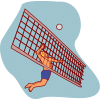With the introduction of the new libero rule in Saskatchewan high schools this
season, the office has been flooded with questions about how to implement the new position. This is a brief introduction both
to the strategies that have commonly been used for the position and the rules that govern its use.
1) Choosing the Libero - the libero should be a player with excellent ball
control skills. He/she should excel at both overhead and underhand passing, and both serve receive and defence. On some teams,
the player with the best ball-control may also be the best hitter or blocker; because the libero is not allowed to play in
the front row, you probably do not want to choose someone whose skills will be missed at the net. At the same time, the Libero
does not automatically need to be the team's smallest player.
2) Who to Replace - the idea behind the rule is to extend rallies by allowing
teams to replace a weak passer with a stronger one. Some teams have assumed that the libero should automatically replace the
back-row middle, or the tallest player on the team, or the best hitter. This may or may not be the case - for example, at
higher levels, some teams make extensive use of back-row attacks, in which case coaches need to decide whether they are willing
to sacrifice these attacks for better defence. Take a good look at your team's player personnel before you make decisions
about who will go in and who will go out. In order to make best use of the rule, you should try to substitute for the player
who is least likely to provide quality back-row contacts. It is important to remember, though, that the Libero does not need
to stay in for the same person the whole way through the back row. As long as the Libero leaves the court for at least one
rally before returning, he/she can replace several different players as different game-situations develop.
3) Where Does the Libero Go - because the libero is essentially a back-row
specialist, you will want to position them in a spot where they will get the largest number of balls. This will vary depending
on the blocking scheme your team uses, but most teams have chosen for their libero to play in either position 5 or 6. To use
the back-row attack as an example again, it is much more common to use back-row attacks from position 1 or 6 than from 5,
so for teams using back-rows, position 5 might be the best spot. Once again, it is important to assess the needs of your particular
team when deciding where you want to position this new player, instead of simply sticking them somewhere because you have
seen other teams doing it.
4) Characteristics of the Libero - the libero's defensive role on the team
means that he/she should be a fearless defender, willing to go after any ball. A take-charge attitude is also an asset because
you will probably want your libero to play any of the in-between balls on free balls or serve receive. Liberos must be confident
and not easily frustrated by one or two bad contacts; they will be counted on to be steady passers, because (as will be covered
later in the "Rules" section) a new libero cannot be substituted in right away.
5) Rules Governing the Libero
a) It is not mandatory to have a libero.
b)
The libero must wear a jersey that is a different colour than those of the rest of the team, and this jersey must bear the
same number that is listed for that player on the score sheet.
c) The Libero can replace any back-row player, but must
come back out before he/she gets to the front row.
d) Replacements involving the Libero are not counted as regular substitutions;
they are unlimited, but once the Libero comes out, he/she must be on the bench for at least one rally before going back in.
e) The Libero is not allowed to serve, block, or attack from either the front or back court.
f) If the Libero is in
front of the attack line, he/she is not allowed to set (overhead pass) to either a front or back row hitter to attack the
ball. If he/she is behind the attack line, this is allowed.
g) For Libero replacements, the officials do not need to be
notified (as with substitutions), but make sure that a) the switch is completed before the service whistle, and b) the players
come in and out on the sideline between the attack line and the end line.
h) Once a game has started, a new Libero cannot
be substituted in. However, a new Libero can be named between games of a match. The exception to this could come in the case
of an injury to the Libero. If the Libero is injured, another player can be legally substituted, but the new Libero must play
for the remainder of that game, and the injured Libero must not play for the rest of the match.
Whether you agree with the rule change or not, it would seem that the Libero is
here to stay. The rule has become a fixture in international, university and even club competition. The best feature of the
Libero may be that it gives smaller players, who may never have seen the court because of a lack of offensive firepower, a
chance to specialize their skills and become valuable contributors to their volleyball teams.

